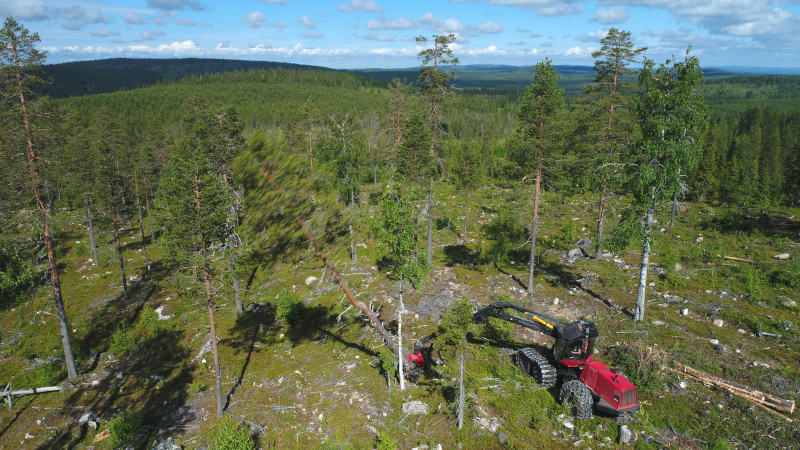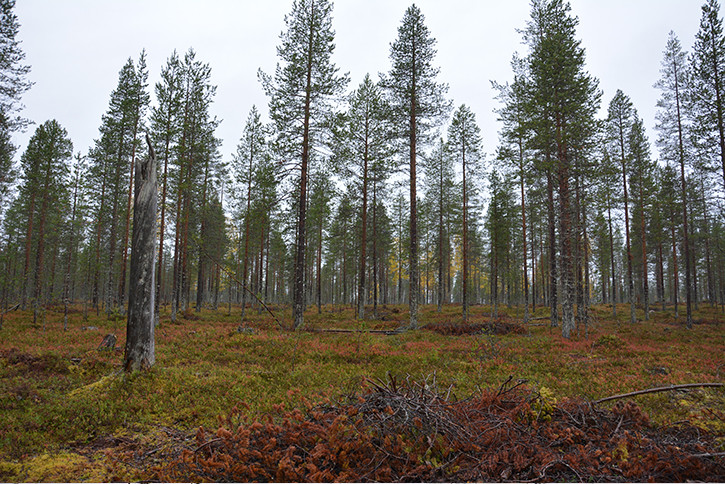Special features of forestry in Northern Finland
As a major landowner and employer, Metsähallitus has a particularly responsible role in Northern Finland.

The importance of Lapland and its natural resources for bioeconomy and tourism is increasing constantly. A solid demand for pulp and products made from it and access to timber have meant that biorefinery projects have also been set up in Lapland. The increased volume and internationalisation of tourism, on the other hand, are reflected in growing tourism infrastructure construction, and sites suitable for accommodation and tourism services are sought in new areas. New wind power, exploration and mining projects are also underway.
Constant dialogue between different actors is required to reconcile the various land use needs.
For Metsähallitus Forestry Ltd, Northern Finland is an important operating area, whereas more restrictions apply to forestry in Lapland than in the rest of the country.
These restrictions are related to protecting old-growth forests and safeguarding forest biodiversity, reconciling reindeer husbandry and forestry, and the needs of tourism and recreational use. In the Sámi Homeland, forestry operations are restricted as agreed with the Sámi Parliament, the Skolt village meeting and the local reindeer herding cooperatives.
Agreements applicable to our operations
Our operations in Lapland and in the reindeer herding area of Northern Finland are regulated by several agreements.
- Cooperation agreement between the Reindeer Herders’ Association and Metsähallitus concluded in 2012 (applies to all units of Metsähallitus)
- Cooperation agreement between the Sámi Parliament, the Skolt village meeting, reindeer herding cooperatives in the Sámi area and Metsähallitus concluded in 2014 (applies to all units of Metsähallitus)
- Separate agreements concluded in 2009 and 2010 with the reindeer herding cooperatives of Hammastunturi, Muddusjärvi, Muotkatunturi and Paatsjoki as well as the Nellim unit on setting key pasture areas aside from forestry activities for 20 years, or for 10 years in parts of Nellim.
Protecting forests and forest habitat in Lapland
There are 2.7 million hectares of productive forests on state land in Lapland. One third of this area is either under statutory protection or excluded from forestry operations by a Metsähallitus decision. Of the forest lands, 8% are in restricted use and 58% within the scope of multiple-use forestry.
Almost one million hectares of old-growth forest in Lapland have been protected.
In forest management and the scaling of forestry operations, we safeguard forest biodiversity. To do so, we take into account landscape ecological plans, which identify ecological sites valuable in terms of biodiversity, cultural sites, and other special sites affecting land use.
As stated in the natural resource plan for Lapland, our goal in forest management is to have a 10% to 30% share of deciduous trees also in forests dominated by conifers, excluding on the most barren sites. We leave behind all deadwood in the felling areas and preserve retention tree groups and game thickets. We additionally preserve live retention trees accounting for 130,000 cubic meters in fellings every year. One to three artificial snags are produced per hectare, totalling around 20,000 a year.
We also carry out ecological management and restoration work in mire and forest habitats and freshwater environments in forestry areas over approx. 100 to 200 hectares a year. In addition to ordinary water protection measures in forestry, we are developing methods for preventing adverse effects on water bodies.
More than 900,000 hectares of old, pristine forests in Lapland have been protected or otherwise excluded from forestry operations. Extensive areas were protected in the 1990s under a protection programme for old-growth forests. Between 2005 and 2019, the area of protected forests in Lapland increased by 161,000 hectares as the ecological network was complemented.
Forestry and reindeer husbandry
The basic principle of Metsähallitus is that forestry and reindeer husbandry can coexist in the same areas. Their reconciliation is guided by an agreement concluded with the Reindeer Herders’ Association and the Environmental guidelines for practical forest management.
We conduct negotiations with individual reindeer herding cooperatives as required under this agreement to discuss fellings and other forestry operations, and we agree on the modes of cooperation in locations that are important for reindeer husbandry. The goal is to work together to develop forestry management methods which address the needs of reindeer husbandry.
The aim of the negotiations is to achieve a mutual understanding. Any unclear issues are checked in the terrain if necessary, and the agreements reached and the maps associated with them are recorded in a memorandum.
When the natural resource plan for Lapland was prepared, we had for the first time access to the reindeer herders’ TOKAT data (geographic information related to reindeer husbandry). Based on this data, all areas with reindeer fences were designated for restricted forestry use, with direct impacts on the possibilities of timber harvesting. We also agreed to identify the most important reindeer grazing areas with each cooperative, using the TOKAT data. We will additionally implement an interactive participatory procedure based on an online map for the use of the reindeer herders’ cooperatives and Metsähallitus.
Forestry in the Sámi Homeland
90% of the Sámi Homeland comprises state-owned land areas managed by Metsähallitus. Of these, 72% are protected and wilderness areas administrated by Metsähallitus Parks & Wildlife Finland, while 13% are areas designated for pursuing traditional livelihoods and administrated by Metsähallitus Property Development. Metsähallitus Forestry Ltd controls 15% of the surface area, of which approx. one half is used for commercial forestry.
We work closely together with the local reindeer herding cooperatives in the Sámi Homeland. We never harvest timber in the Sámi Homeland unless a preliminary agreement on it has been reached with the reindeer herding cooperative.
Natural resource plan for the Sámi Homeland to be updated
In spring 2020, Metsähallitus, the Sámi Parliament, the Skolt village meeting and the reindeer herding cooperatives in the forests of the Sámi Homeland initiated a conflict mapping process together. In this process, a neutral party interviews a broad selection of actors in the area and prepares recommendations for actions with the aim of improving cooperation between Metsähallitus’ business activities and the Sámi stakeholders. In the natural resource plan, the scale and practices of forestry operations will be determined in cooperation with each reindeer herding cooperative in the Sámi Homeland.
Planned cut in the natural resource plan for Lapland

The scaling of forestry operations is based on sustainable use of forest resources over generations. We prepare the felling calculations based on new forest resource data, updated landscape ecological plans, restrictions imposed by other forms of land use and common policies agreed in natural resource planning.
In keeping with the natural resource plan for Lapland, we offer approx. 1.9 million cubic meters of timber sourced in the planning area (the region of Lapland, excluding the Sámi Homeland) to the market every year. The average annual area of regeneration fellings is 10,000 hectares and the area of thinnings is 21,000 hectares.
A more specific harvesting plan has been produced since the earlier natural resource plan was completed. The planned cut was calculated in four sections for the areas of the Southern, Western, Central and Eastern Lapland forest teams. Current factors restricting fellings were accounted for in the calculations of harvesting volumes, including the geographical information updated in 2017 and 2018 on ecological sites in forestry areas and special sites that have an effect on forestry operations. Special areas which are of great importance for different parallel land use forms have specific felling targets. On sites where forestry operations are restricted, the annual regeneration area is no more than 0.7% of the surface area of this category.
Additionally, sites which are challenging in terms of their yield and regeneration are taken into consideration in the planned cut. Protected areas and other sites administrated by Parks & Wildlife Finland are excluded from the calculations.
Harvesting techniques in the forests of Lapland
We select appropriate harvesting methods based on the conditions of each individual site. We use different harvesting and forest management techniques diversely to safeguard landscapes important for nature tourism and recreational use, the operating environments of reindeer husbandry, and valuable grazing areas.
Together with research institutes and the stakeholders, we develop diverse techniques suitable for areas with different land use needs and growth conditions, including continuous cover forestry. We set the minimum age limit of 70 years for the regeneration of forests dominated by conifers. Dry heaths with pine forests located on high ground (over 280 m above sea level) were included in continuous cover forestry in the harvesting calculations. This means that only cutting intended to promote forest growth can be carried out there.
We use improved seeds and seedlings as far as possible to regenerate the forests in Lapland. We safeguard forest regeneration by maintaining a security stock of forest tree seeds.
Only one half of the planned volume harvested in Northern Lapland
Metsähallitus has not carried out any clear cuttings in the northernmost parts of Lapland for the past 25 years. Forest management is based on natural regeneration of pine stands by means of seed tree felling or different felling techniques that maintain forest cover.
We never harvest timber in the Sámi Homeland unless a preliminary agreement on it has been reached with the reindeer herding cooperative.
In 2018, less than one half of the planned cut indicated in the natural resource plan was realised on state-owned land in Inari, as three reindeer herding cooperatives in this municipality announced their refusal to accept any harvesting in their operating area. The forestry problems in Inari have widespread multiplier effects on such issues as firewood deliveries to local residents, road maintenance, management of young stands and other forests, customers’ attitude toward accepting timber, as well as contracts with entrepreneurs and staffing.